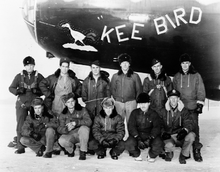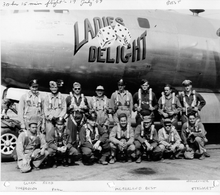46th Reconnaissance Squadron
| 46th Reconnaissance Squadron | |
|---|---|
|
Emblem of the 46th/72d Recon Association | |
| Active | 1943–1947 (until 1955 with 72d Reconnaissance Squadron) |
| Country | United States |
| Branch | United States Army Air Forces |
| Role | Reconnaissance |





The 46th Reconnaissance Squadron is an inactive Strategic Air Command unit. Its last assignment was with the 5001st Composite Wing, based at Ladd Army Airfield, Alaska Territory.
It was redesignated on 13 October 1947 as the 72d Reconnaissance Squadron, and operated as the 72d Reconnaissance Squadron until 30 September 1955 when the squadron was redesignated as the 72nd Bombardment Squadron, Heavy and performed a mission change from reconnaissance to a B-36 Peacemaker strategic bomber squadron.
The 46th Reconnaissance Squadron was assigned the Strategic Air Command's first operational mission, "Project Nanook," - to assess the Soviet threat in the Arctic at the beginning of the Cold War. The unit developed the Grid System of Navigation which opened up the Arctic skies to world aviation and enabled SAC to become a global deterrent force.
The squadron's F-13 45-21848 - 46th Recon Aircraft "848" - was the first aircraft to fly over the Geographic North Pole on 16 October 1946.
History
Established as at B-24 Liberator heavy bomber replacement training unit. Converted in September 1943 for operational training; assigned to Second Air Force for training. Deployed to Mediterranean Theater of Operations (MTO) in December 1943, squadron taking the South Atlantic Transport Route though the Caribbean and South America; transiting the Atlantic Ocean via Brazil and Dakar, French West Africa, being assigned to Fifteenth Air Force in January 1944 at Grottaglie Airfield in Southern Italy.
Engaged in long-range strategic bombardment of enemy military, industrial and transport targets, including oil refineries and production oilfields in Italy; France; Southern Germany; Austria and the Balkans. Continued strategic bombardment until German capitulation in May 1945. Most of the squadron was demobilized in Europe; small cadre reformed at Sioux Falls Army Airfield, South Dakota in late May, being redesignated as a B-29 Superfortress Very Heavy bomber squadron. Equipped with B-17 Flying Fortresses and new personnel, began training for deployment to Central Pacific Area (CPA) to engaged in strategic bombardment missions over Japan. Japanese capitulation in August canceled plans for re-deployment, after training was reassigned to Grand Island Army Airfield, Nebraska as part of Continental Air Command.
Redesignated as 46th Reconnaissance Squadron in June 1946. New mission was to provide very long range reconnaissance as part of the newly established Strategic Air Command. Equipped with eighteen Reconnaissance-modified B-29 Superfortresses obtained at Grand Island Army Airfield, Nebraska. Eight of the aircraft were modified into the F-13A reconnaissance configuration, being fitted with special camera installations for photographic mapping and recon work. The F-13As carried three K-17B, two K-22 and one K-18 cameras with provisions for others. However, the standard B-29 bombing equipment and defensive armament were retained.
The squadron was assigned to Ladd Army Airfield, Alaska Territory on 1 June 1946 with a mission to fly reconnaissance and photo-mapping missions over the Arctic and perform reconnaissance along the northern border of Soviet territory in the Arctic, as well as deep-penetration reconnaissance flights. All of its missions were classified as Top Secret, the classification wasn't dropped until 2001.
The squadron flew its first operational mission on 2 August 1946 from its base at Ladd, eventually flying more than 5,000 hours in the Arctic and over 1,000,000 miles in its first year of operations, testing material and the limits of flying personnel in the Arctic. It made the first aircraft flight over the Geographic North Pole on 16 October 1946, eventually accomplishing over 100 flights to the pole and its immediate vicinity. It performed photo mapping of 5,500,000 square miles of the Arctic, including areas for the strategic location of defense components, and future locations of radar sites along the northern Canadian region. Exploratory flights were made to obtain information necessary to establish commercial airline service over the Arctic.
When the squadron arrived in Alaska, large areas of the territory and northern Canada were largely unexplored. The squadron developed means of polar navigation necessary due to the unreliability of magnetic compasses, and many existing maps of the region were unreliable. The Grid System of Navigation was developed which enabled navigators to navigate to locations within one mile of accuracy.
The squadron was redesignated as the 72d Reconnaissance Squadron on 13 October 1947; its personnel and equipment being absorbed by the new unit in a name-only change. It operated as the 46th/72d Reconnaissance Squadron until 28 June 1949 when the squadron was reassigned to Mountain Home AFB, Idaho.
Lineage
- Constituted as: 719th Bombardment Squadron (Heavy) on 6 April 1943.
- Activated on 1 May 1943
- Inactivated on 11 June 1945
- Redesignated: 719th Bombardment Squadron (Very Heavy) on 7 September 1945
- Activated on 17 September 1945
- Redesignated: 46th Reconnaissance Squadron (Very Long Range, Photographic) on 1 June 1946
- Inactivated on 13 October 1947. Equipment and personnel absorbed into 72d Reconnaissance Squadron, organized on 13 October 1947
Note: The 46th Reconnaissance Squadron (25 June-15 August 1943), assigned to the 426th Reconnaissance Group has no lineage to this organization. It was never manned or equipped.
Assignments
- 449th Bombardment Group, 1 May 1943 – 11 June 1945; 17 September 1945
- Fifteenth Air Force (SAC), 4 August 1946
- Alaskan Air Command, 19 August 1946
- Yukon Sector, Alaskan Air Command, 1 October 1946
- 426th Reconnaissance Group, 1 July-15 August 1943
- Strategic Air Command, 1 May 1946
- Attached to: Yukon Sector, Alaskan Air Command until inactivation on 13 October 1947
Stations
- Davis-Monthan Field, Arizona, 1 May 1943
- Alamogordo Army Air Field, New Mexico, 5 July 1943
- Bruning Army Airfield, Nebraska, 12 September 1943 – 26 November 1943
- Grottaglie Airfield, Italy, 3 January 1944 – 15 May 1945
- Sioux Falls Army Air Field, South Dakota, 29 May-11 June 1945
- Grand Island Army Airfield, Nebraska, 17 September 1945
- Ladd Army Airfield, Alaska Territory, 1 June 1946 – 13 October 1947
Aircraft
- B-24 Liberator, 1943–1945
- B-17 Flying Fortress, 1945
- F-13A Superfortess, 1946–1947
- 44-86338 - Unnamed (Damaged Nose/Wingtip - Hangar/Parts Aircraft)
- 44-86339 - "Carmencito Joe"
- 44-87742 - The Barrow Sparrow" (F-13A)
- 45-21742 - Unnamed (F-13A)
- 45-21761 - "Boeings Boner"
- 45-21762 - Unnamed (F-13A)
- 45-21763 - "The Northern Star"
- 45-21766 - "Bucket of Bolts"
- 45-21768 - "Kee Bird" (F-13A)
- Abandoned February 21, 1947 on frozen lake in Greenland. Remained abandoned on lake for many years. During attempt to recover, caught fire and burned May 21/22, 1995.
- 45-21773 - "Leaking Lena" (F-13A)
- 45-21775 - "Forlorn Turkey" (F-13A)
- "The Forlorn Turkey" crashed into hillside on Seward Peninsula, December 23, 1947 95 mi N of Nome, AK (east slope of Hot Spring mountain). 2 died while attempting to walk out to get help, 6 rescued. 3 rescue men died.
- 45-21777 - "My Achin' Back" (F-13A)
- 45-21819 - Unnamed
- 45-21846 - "Over Exposed" Converted to B-29F
- 45-21848 - Acft. "848" (First Aircraft in history to fly over North Pole) Crashed 1947 "Dreamboat" (Long range configuration)
- 45-21853 - "We've Had It" Converted to B-29F Crashed on takeoff December 12, 1946
- 45-21856 - Unnamed Converted to B-29F
- 45-21859 - "Ladies Delight" "Dreamboat" (Long range configuration)
- 45-21871 - Unnamed
See also
References
![]() This article incorporates public domain material from websites or documents of the Air Force Historical Research Agency.
This article incorporates public domain material from websites or documents of the Air Force Historical Research Agency.
- Maurer, Maurer, ed. (1982) [1969]. Combat Squadrons of the Air Force, World War II (reprint ed.). Washington, DC: Office of Air Force History. ISBN 0-405-12194-6. LCCN 70605402. OCLC 72556.
"World in Peril; The Origin, Mission, and Scientific Findings of the 46th/72nd Reconnaissance Squadron," by Ken White. 1994 ISBN 1-883218-10-1
